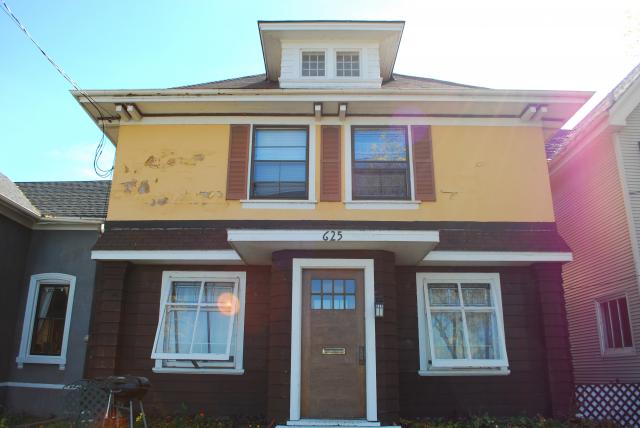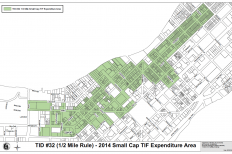






 The city has extended the Small CAP TIF loan program to Tenney-Lapham, meaning homeowners who live on their property can obtain forgivable loans to purchase and renovate home in the neighborhood (Aparna Vidyasagar/Madison Commons)
The city has extended the Small CAP TIF loan program to Tenney-Lapham, meaning homeowners who live on their property can obtain forgivable loans to purchase and renovate home in the neighborhood (Aparna Vidyasagar/Madison Commons)
Look closely, and a house will tell you a piece of its story.
In the Tenney-Lapham neighborhood, some homes tell a bleaker tale than others.
Houses encrusted with scrolls of peeling paint or with front porches in disrepair dot portions of East Johnson and East Gorham streets. For these deteriorating homes there are only two options -- renovate or raze.
Ledell Zellers, alder for District 2 that includes the Tenney-Lapham neighborhood said such properties are often rentals, owned by landlords who typically do not live in the neighborhood. Though some landlords do a reasonable job, Zellers said they generally see the buildings they own as simply being cash flow and are careful about putting money into their properties.
“If they (the landlords) live in a neighborhood, they tend to pay more attention to the quality of the housing that they are renting,” Zellers said.
So, the city is looking to convert rentals into units in which the owner lives on the premises; be it as a single-family unit or a rental property. ‘Owner-occupant’ is the technical term, and the city is doing so, through a loan program called the Small CAP TIF loan.
At present, the program is in effect for a part of the Tenney-Lapham neighborhood - the area between East Johnson and East Gorham streets from North Blair Street to Brearly Street.
Essentially, the program provides a forgivable loan to individuals interested in purchasing a property and renovating it. That person must stay on at the property, or within a year of the loan closing, sell to someone who will. If the owner-occupant lives at the address for ten years, the loan is forgiven. There are other conditions to the loan. There can only be a maximum of three units in a building and 10 percent of the funds must be used to renovate the exterior.
An informational session on the CAP TIF program will be held Oct. 25 from 2 to 5 p.m. at the Mendota Lake House Bed and Breakfast (704 E. Gorham St.) More information is on the City of Madison website.
The Tenney-Lapham neighborhood is one of the oldest in the city, dating back to the late 1800s. Many of the houses in the area covered by the small CAP TIF program reflect the historic roots of the neighborhood.
“It’s important to the neighborhood to maintain historic character and human scale with front porches, trees and yards. Otherwise, it can get gobbled up,” said Joe Lusson,a long-time Tenney-Lapham resident who has served as president of the Tenney-Lapham Neighborhood Association (TLNA) and has served on the board of This map shows the boundaries for the Small Cap TIF loan program (courtesy City of Madison) the Madison Trust for Historic Preservation.
This map shows the boundaries for the Small Cap TIF loan program (courtesy City of Madison) the Madison Trust for Historic Preservation.
Lusson pointed to examples like the City Row apartment complex on East Johnson Street, While he considered that a successful project, too many such developments can come at a cost to neighborhood character. City Row stands in place of 11 older houses and several trees.
“We’ve been at a crossroads for some time now where these houses are either going to be torn down or restored [...] So this program is an awesome tool to do that (restore),” Lusson said.
This isn’t the first time a small CAP TIF loan has been offered in the city. A version of the program was offered in the Bassett neighborhood in 2007, and is currently being offered in Greenbush. It has been offered in the James Madison Park-Mansion Hill neighborhood for some time. Zellers said the city has not promoted the program. So far this year, two loans have been distributed for renovations in that area.
The city recently added the Tenney-Lapham neighborhood to the James Madison Park-Mansion Hill Small CAP TIF expenditure area. The city has allotted a loan amount of $80,000 for a single unit property. A two-unit property will receive $90,000; and a three-unit, $100,000. Each is $20,000 higher than the initial loan amounts. Secondly, the provision for an individual to renovate and then sell to an owner-occupant was added, giving interested parties a little more flexibility. Zellers believes these changes will make it more attractive.
Saturday’s session will feature representatives from the city, as well as real estate and financial experts to answer questions. Lusson also plans to show properties that are potential candidates for the loan and older homes that have been successfully renovated.
Sam Irwin has been living in Tenney-Lapham for three months having previously lived on Williamson Street for a year. He has noticed some of the homes that have fallen into disrepair in the neighborhood. According to Irwin, repairing and renovating buildings (especially older ones) that would have otherwise been neglected, benefits the neighborhood as a whole by bringing in those invested in a property and the neighborhood for the long term.
“It’s equally good to put in the time now, and save (time and money) later,” he added.
Another Tenney-Lapham resident, Leif Brottem, has owned his home for seven years. While he has been aware of programs similar to the Small CAP TIF in the past, he hadn’t heard about the program in his neighborhood.
“The more owners who live on the premises the better especially if they are also rental properties,” Brottem said. “Anything they can do to fix up homes and keep it affordable (is a good thing).”
Both Lusson and Zellers are hopeful the information session will get the word out about the program
“The sky’s the limit,” said Lusson referring to how many he hopes will take advantage of the program.
|
|
|
Welcome to the Madison Commons, a website designed to provide news and information about all of Madison's neighborhoods and a crossroads for the discussion of community issues. The name comes from the idea of a village commons, a place for news, talk, debate, and some entertainment, too, that's open to everyone.
All rights reserved. Read more about the Madison Commons and its partners.

